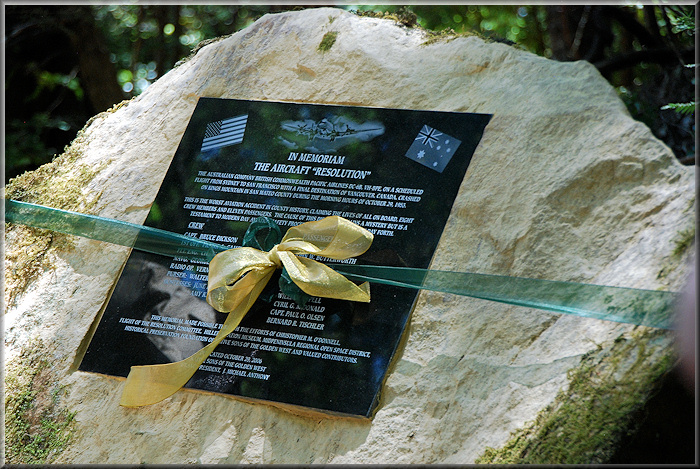A history marker on Kings Mountain commemorates the deadliest airplane tragedy in San Mateo County history, the crash of an Australian airliner that killed 19 people. An even more vivid reminder is that some of the wreckage is still there.
The British Commonwealth Pacific Airlines DC-6 named “Resolution” was flying from Sydney to San Francisco on Oct. 29, 1953, when – only three minutes from its destination – the plane slammed into the mountain west of Redwood City, cutting a path through an area jammed with trees and starting several fires with its shower of fuel.
“The sight was one of absolute devastation,” reported San Mateo Times’ photographer Ray Zirkel, who flew over the wreckage in a helicopter and brought back the first photos from the fog- and smoke- shrouded hillside. “Nothing moved, only great chunks of twisted, unrecognizable debris lay over the mountainside. The only thing that was left resembling a plane was a buried, torn wing. Apparently more wreckage was buried in the forest which we couldn’t see.”
Wreckage Remains
Some of that wreckage remains to this day just yards from a trail in El Corte de Madera Open Space Preserve, which is managed by the Midpeninsula Regional Open Space District. A few years ago this writer hiked to the area to take some photos but was talked out of it by his hiking pal, then a mechanic for a major airline. “Bad luck,” he said, convincing me that taking pictures to placate mere curiosity would have been a bit morbid as well as spooky. Then, that is just my moral compass at work. “Please respect this historical site by leaving any artifacts where you find them,” the district urges on its website.
The Civil Aeronautics Board determined that “the probable cause was the failure of the crew to follow proscribed procedures for an instrument approach.” According to La Peninsula, the journal of the San Mateo County Historical Association, pilot Capt. Bruce Dickson, 34, was a veteran of more than 100 approaches to San Francisco . In a lengthy article in 1991, the journal speculated that Dickson “must have felt confident, maybe even overconfident as he hit a bank of normal coastal fog. He knew what to do,” adding “or so he thought.” Why would a trained and experienced pilot fail to follow procedures? “No one will ever know for sure,” La Peninsula concluded.
During the initial attempted rescue and recovery efforts, much of the airplane wreckage was left in place, according to the district’s public affairs office. The wreckage became what was called an “informal history site” when the crash area was in private hands as a logging operation. After the district acquired the land, the decision was made to formally recognize the tragedy. The trail leading to the crash site was named “Resolution Trail” and a memorial plaque was donated by the Native Sons of the Golden West. The plaque, anchored on a rock, was placed in 2009 near where Fir Trail intersects with Resolution Trail, which starts below a knoll that served as the base for rescue operations.
A Makeshift Morgue
The National Guard Armory in Redwood City was pressed into service as a temporary morgue. Searchers found 17 bodies on the first day of the search and two a day later. There were no survivors. The victims included an accomplished musician, 31-year-old pianist William Kapell, who was returning from a series of concerts in Australia. When he was only 20, the New York musician became the youngest person to win the Town Hall endowment series award. The honor was bestowed in 1942, the same year he made his first appearance as a soloist with the New York Philharmonic. Two years later he signed an exclusive contract with RCA-Victor.
Kapell’s tour of Australia included 37 concerts in 14 weeks. He wasn’t happy with some of the reviews. Before he got on the plane at Sydney, he told reporters: “This is goodbye forever – I shall never return.” His final concert included Chopin’s “Funeral March.”






